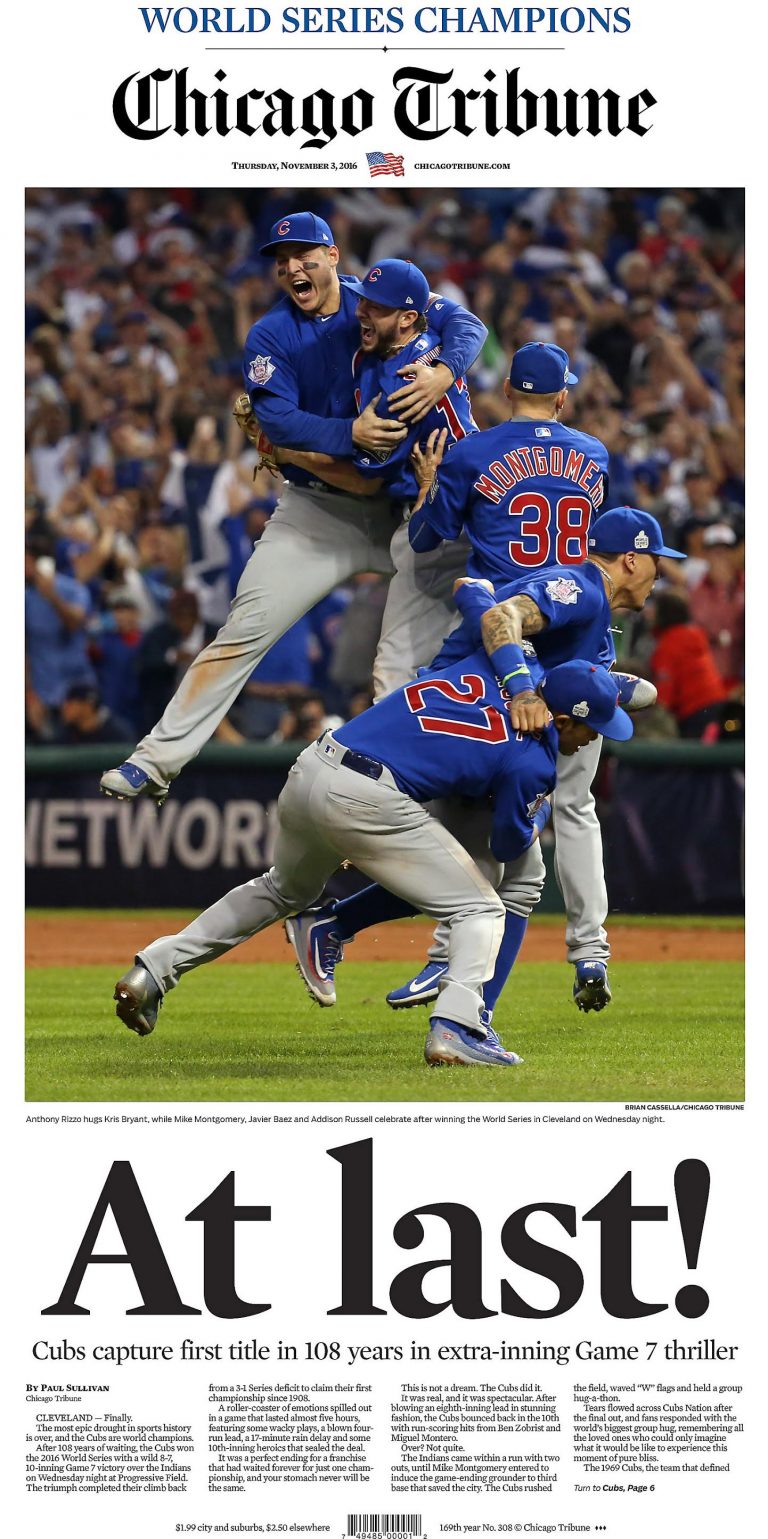
Former DTH Photo Editor Brian Cassella took the picture shared around the world when the Cubs won the World Series in 2016.
By Kellen Short
Class of 2010
The Cubs’ first World Series title in 108 years called for a remarkable front page, and DTH alum Brian Cassella helped the Chicago Tribune deliver a grand slam.
The photojournalist credits preparation, teamwork and old-fashioned luck for allowing him to immortalize the Cubs’ victory in photos, helping the newspaper sell more than 1 million copies to long-awaiting fans.
“You make a plan for what you want to do,” Cassella said. “You don’t just react at the last minute.”
Cassella set up two remote cameras in preparation for Game 7, but he shot primarily from a Canon 1D X with a 200-400 mm lens that transmitted images automatically to the newspaper’s FTP server via an Ethernet line. Laptops were not permitted near the field, and the four Tribune photographers couldn’t miss a second, so they also sent short audio captions instantly to the newsroom.
During the game, he retrieved photos from the server to share from his personal Twitter account.
The pressure of high-stakes athletics was nothing new to Cassella, a 2005 UNC graduate.
He’s shot the Rio Olympics, three Stanley Cup finals, a Super Bowl and numerous college championships for the Tribune and the St. Petersburg Times (now Tampa Bay Times), where he worked from 2005-09.
Cassella also spent seven seasons developing a deep understanding of the Cubs roster and the players’ relationships to predict how they might celebrate if they clinched the victory.
He considered trying to capture the pitcher and catcher converging on the mound – a classic World Series image – but in the 10th inning, the Cubs sent in relief pitcher Mike Montgomery, a lesser-known recent recruit who wasn’t exactly the face of the team.
As the longest-tenured Cub, first baseman Anthony Rizzo was a good possibility for an emotional reaction, Cassella said. When Rizzo sealed the deal on the final out, he raced toward his best friend on the team, third baseman Kris Bryant – just as Cassella anticipated.
“A lot of sports photography is just remembering what happened last time,” he said. “It’s not just instincts.”
After a few seconds of furious shooting, Cassella had his shot – or at least hoped he did. Without reviewing his images, he left his camera transmitting photos and headed onto the field with a wide angle to capture the celebrations more closely. Before he ever saw the photo in the back of his camera, editors in Chicago had placed it on the page.
The result was an iconic front with Cassella’s shot stretched across six columns, framed by a massive 240-point headline — “At last!” — punctuated by the rarely used exclamation point.
Media pundits noticed, and Twitter buzzed with comparisons between the Tribune’s bold cover and the underwhelming Chicago Sun-Times, which featured a wider shot with mostly players’ backs. Could the difference be attributed to the Sun-Times’ decision to lay off its photo staff in 2013, critics mused?
As Cassella explained in his blog, The Second Take, he thinks his competitors’ shortfall stemmed more from editing than shooting. An AP photographer took the image the Sun-Times chose, and Cassella said he was confident that AP shooter had better options that simply weren’t chosen.
Still, he praised the Tribune’s editing team for ensuring that they adequately captured the drama of the moment. Fans seeking copies found the Tribune sold out throughout the city while the Sun-Times remained stacked high.
Cassella acknowledged that capturing a shot worthy of the moment also required a bit of luck. When the game ended, he had only five or six seconds to capture the players’ grins before the celebration dissolved into a faceless dogpile. And with two base coaches, six umpires, two runners on base, security guards and TV crews, a stray pedestrian could have easily ruined the prime shots.
“You’re making a plan, but you’re also just hoping for the best, and a lot can go wrong,” Cassella said.
When he’s not covering the World Series, Cassella shoots assignments of all types and produces a photo column called “The Next Day.” The column chronicles the vitality of Chicago neighborhoods by photographing daily life on city blocks 24 hours after gun violence there.
He credits UNC professors such as Pat Davison for teaching him the importance of telling people’s stories honestly and truthfully, whether it’s a World Series win or kids drawing with chalk in the park.
“Being a photographer is a way to explore your community in a way that you never would without a camera,” Cassella said. “It’s kind of this passport into what’s going on around you.”